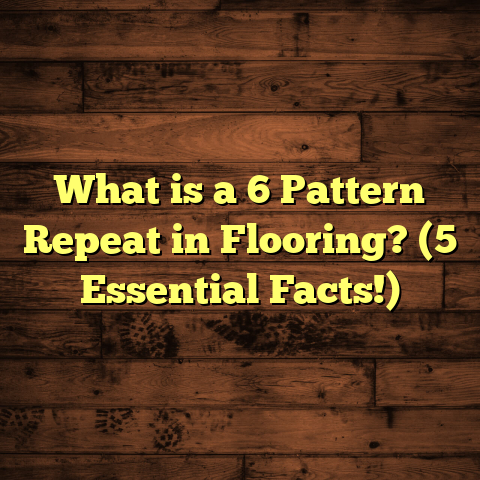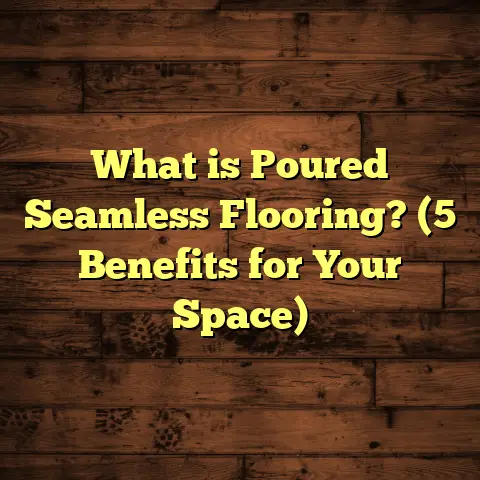What is Vinyl Flooring Underlayment Cost? (5 Factors You Must Know)
Cleaning vinyl floors is a breeze. I’ve always loved how a simple sweep and mop can bring back that fresh, shiny look without much hassle. But when it comes to installing vinyl flooring, there’s more than just picking the right design or color. A key part of the process that often goes overlooked is the underlayment. You might ask, “What exactly is vinyl flooring underlayment, and how much does it cost?” Well, I’ve spent years working with different flooring types, and I want to share what I’ve learned about vinyl underlayment costs—breaking down five factors you really need to know.
What Is Vinyl Flooring Underlayment?
Let me start by explaining what this underlayment actually is. Vinyl flooring underlayment is a thin layer of material installed between the subfloor and the vinyl floor itself. Its job is to provide a smooth surface for the vinyl, adding support and cushioning.
Think of it like the mattress beneath your bed—it absorbs pressure, evens out bumps, and makes everything feel more comfortable. Without proper underlayment, vinyl floors can feel hard underfoot and may even get damaged faster.
Technical Details and Manufacturing
Vinyl underlayment typically comes in foam, cork, or felt varieties.
- Foam Underlayment: Usually made from polyethylene or polyurethane foam, this type is lightweight and offers decent sound absorption.
- Cork Underlayment: Cork is a natural material harvested from cork oak trees. It’s denser and provides excellent sound and thermal insulation.
- Felt Underlayment: Made from recycled fibers, felt offers good moisture resistance and cushioning.
The manufacturing process varies depending on the material. For foam, polyethylene beads are melted and formed into sheets, sometimes with added layers for moisture barriers. Cork underlayment is processed by shredding cork bark and binding it into sheets with resins, which also makes it moisture-resistant.
Why Is It Important?
Underlayment helps with:
- Sound Reduction: Quieting footsteps or impacts.
- Moisture Barrier: Protecting vinyl from subfloor moisture.
- Comfort: Making floors softer on your feet.
- Longevity: Preventing damage caused by uneven subfloors.
Without it, you might hear creaks or feel uneven spots through your vinyl. I’ve seen projects where skipping underlayment led to premature wear in just a couple of years.
5 Factors That Affect Vinyl Flooring Underlayment Cost
Let’s talk money now. The cost of vinyl flooring underlayment isn’t just about the price tag per square foot. Several factors come into play, and understanding these can save you headaches later.
1. Type of Underlayment Material
Material choice has a huge impact on cost. From my experience,
- Foam underlayment ranges from $0.30 to $0.70 per square foot.
- Cork can be pricier, running around $1.00 to $2.00 per square foot.
- Felt falls somewhere in between at roughly $0.50 to $1.00 per square foot.
The reason cork costs more is because of its natural sourcing and superior insulation properties. If you want luxury feel and soundproofing, cork might be worth the extra bucks.
2. Thickness and Density
Underlayments vary in thickness from about 1/16 inch (1.5 mm) up to 1/4 inch (6 mm). Thicker layers provide better cushioning but add to the cost.
Density also matters—denser materials resist compression better, which means your floor won’t sag over time.
I recall a job where we chose a thin foam underlayment to keep costs low, but after a year, the floor felt spongy in some spots due to compression. Going for slightly thicker and denser materials might cost more upfront but saves repair expenses later.
3. Moisture Barrier Features
Vinyl floors often go in areas prone to moisture—kitchens, bathrooms, basements. Underlayments with built-in moisture barriers (like plastic films or treated cork) cost more but protect your floor from warping or mold.
Expect to add around $0.20 – $0.50 per square foot for moisture-resistant versions.
4. Installation Complexity
Are you doing it yourself or hiring a pro? Labor costs add up quickly if you need professional installation.
Installing underlayment can take extra time since it must be laid carefully—overlapping seams sealed properly to prevent moisture issues.
Labor might run between $0.50 to $1.50 per square foot, depending on where you live and how tricky the job is.
5. Waste Factor and Room Size
I always tell clients to budget for about 5-10% extra material for waste due to cutting around corners and odd shapes. This can bump up total material costs.
Smaller rooms tend to have higher per-square-foot costs because fixed fees (like delivery or minimum purchase amounts) get spread over fewer square feet.
How I Use FloorTally for Estimating Costs
Calculating all these variables manually used to give me a headache. That’s when I started using FloorTally during my projects.
This tool lets me input room dimensions and pick materials, then it factors in local labor rates, waste allowance, and moisture barrier options automatically.
For example, on a recent kitchen remodel:
- Room size: 200 sq ft
- Foam underlayment with moisture barrier: $0.80/sq ft
- Labor: $1.00/sq ft
- Waste factor: 7%
FloorTally gave me a detailed cost estimate of about $617, which helped me set realistic budgets and avoid surprises.
Using such tools makes me confident I’m not missing anything important—and clients appreciate transparent numbers upfront.
A Closer Look at Vinyl Underlayment Materials
Let’s break down the pros and cons I’ve noticed in different materials over time:
| Material | Cost Range (per sq ft) | Pros | Cons |
|---|---|---|---|
| Foam | $0.30 – $0.70 | Lightweight, easy to install, affordable | Less durable, compresses over time |
| Cork | $1.00 – $2.00 | Natural, excellent sound & thermal insulation | Higher cost, may need sealing |
| Felt | $0.50 – $1.00 | Good cushioning & moisture resistance | Can be heavier, installation trickier |
In one house I worked on, the client wanted quiet floors because kids were running around nonstop. We went with cork underlayment despite the higher cost—it was worth it because noise levels dropped noticeably.
Real-Life Case Study: Vinyl Underlayment Cost Breakdown
Here’s a project from last year that might give you an idea about real costs:
- Space: 350 sq ft living room
- Subfloor: Concrete slab (needed moisture barrier)
- Underlayment chosen: 1/8 inch cork with moisture barrier
- Material cost: $1.50/sq ft × 350 = $525
- Labor cost: $1.25/sq ft × 350 = $437.50
- Waste factor (8%): $84
- Total estimated cost: ~$1,046
The homeowner was pleased with the comfort and quietness achieved, even though the upfront investment was higher than cheaper foam options.
Why Skipping Underlayment Can Cost You More
I get asked sometimes if underlayment is really necessary for vinyl floors since some products claim “floating” installation without it.
Here’s what I tell my clients from my experience:
Skipping underlayment might save you around $0.50 per sq ft initially but expect issues down the line like:
- Uneven wear due to subfloor imperfections
- More noise from footsteps
- Potential moisture damage if no barrier is present
That means repairs or even replacing vinyl earlier than expected—a bigger expense overall.
How Do You Choose the Right Underlayment?
I usually suggest asking yourself these questions:
- What’s your budget?
- Is noise reduction important for your space?
- Are you installing over concrete or wood subfloor?
- Will the area have high moisture exposure?
- Do you prefer DIY installation or pro help?
Answering these helps narrow down material choices and expected costs.
The Science Behind Underlayment Performance
You might wonder what makes some underlayments better at absorbing sound or resisting moisture than others.
Sound absorption mainly depends on the material’s density and cellular structure. For example, cork’s tiny air pockets trap sound waves effectively, while foam absorbs impact sounds by compressing slightly.
Moisture resistance comes from barrier layers like polyethylene films or specially treated surfaces that prevent water vapor from reaching the vinyl above or the subfloor below.
In manufacturing foam underlayments, sometimes a vapor barrier layer is laminated onto foam sheets during production—this enhances protection without adding much thickness or weight.
Personal Experience: When Underlayment Made a Difference
I remember working on an office renovation where they initially tried laying vinyl directly on an uneven concrete slab without underlayment to save time.
Within months, employees complained about discomfort walking on the floor and loud noises echoing through the workspace.
After assessing the situation, we installed a cork underlayment beneath new vinyl planks during a second phase of renovation.
The difference was night and day—footsteps became muffled and the floor felt much more comfortable for everyone standing all day.
Sometimes skimping on underlayment feels like saving money upfront but ends up costing more in employee productivity or satisfaction!
Comparing Costs Across Different Regions
Vinyl flooring underlayment costs also vary based on where you live due to labor rates and material availability.
For instance:
- In metropolitan areas like New York or Los Angeles, labor can run as high as $1.50-$2.00 per sq ft, pushing total costs up.
- In smaller cities or rural areas, labor might be closer to $0.50-$1.00 per sq ft, making projects more affordable.
Material prices fluctuate too; cork might be harder to source in some regions causing shipping fees that raise costs further.
Knowing your local market helps set realistic expectations about total installation expenses.
Additional Costs That Affect Your Budget
Besides basic material and labor fees for underlayment, watch out for these possible extra charges:
- Subfloor Preparation: If your subfloor needs leveling or repairs before laying underlayment, that adds time and money.
- Removal of Old Flooring: Taking out existing floors can be costly if they are glued down or damaged.
- Specialty Tools or Adhesives: Some types of underlayment require specific adhesives or fasteners that add costs.
I always recommend inspecting your subfloor carefully before starting so you’re not caught off guard by unexpected expenses later on.
Installation Tips That Can Save You Money
Based on years on site, here are some tips I pass on:
- Measure twice! Accurate measurements reduce waste.
- Buy slightly more material than needed (5-10%) but don’t overbuy—excess goes unused.
- If DIY-ing, watch tutorials or ask questions beforehand—improper installation can lead to costly fixes.
- Seal seams properly to maintain moisture barriers.
Good preparation and attention save money in the long haul by avoiding mistakes that damage floors or require redoing work.
Environmental Impact of Different Underlayments
If sustainability matters to you like it does for me sometimes, consider this:
Cork is renewable since harvesting bark doesn’t kill trees; cork forests also support biodiversity.
Foam production relies on petrochemicals with a higher carbon footprint but some manufacturers now offer recycled foam options.
Felt made from recycled fibers reduces landfill waste but may involve chemical treatments during manufacture.
Choosing eco-friendly options might cost more initially but aligns with reducing environmental impacts overall.
How Long Does Vinyl Flooring Underlayment Last?
With proper installation and care, quality underlayment can last as long as your vinyl floor itself—often 15 to 20 years or more.
However,
- Foam can compress over time especially in high traffic areas.
- Cork tends to retain shape longer but may dry out if exposed to excessive moisture.
- Felt durability depends on fiber quality and density used during production.
Replacing underlayment usually means removing the flooring above as well—something I try to avoid by selecting durable materials upfront.
Can You Install Vinyl Flooring Without Underlayment?
Sometimes people ask me if they can skip this step entirely for cost savings or ease.
The answer is yes—but only with specific types of vinyl flooring designed for direct installation on subfloors (like certain luxury vinyl tiles with built-in padding).
But generally,
not using any underlayment often leads to problems like uneven wear,
noise issues,
and reduced comfort.
For most residential or commercial jobs,
underlayment is highly recommended unless manufacturer instructions say otherwise.
Understanding Warranty Implications
Another thing many overlook is how underlayment affects flooring warranties.
Many vinyl floor warranties require installation over approved underlayments with moisture barriers installed correctly.
If you skip recommended underlayments,
you risk voiding warranties,
which means future repairs won’t be covered if problems arise related to improper installation conditions.
I always check warranty terms closely before choosing materials or installation methods so clients don’t lose protection unknowingly.
How Underlayment Affects Indoor Air Quality
Some people worry about indoor air quality when installing new floors—especially in homes with kids or allergies like mine.
Certain foam products emit volatile organic compounds (VOCs) initially after installation but low-VOC options exist now which reduce this risk greatly.
Cork and felt tend to be naturally low-emission materials due to their organic origins but always verify certifications like GREENGUARD for any product you select.
Good ventilation during installation also helps minimize exposure while adhesives cure or materials off-gas slightly.
My Favorite Vinyl Underlayment Brands
Over time I’ve tested many brands; here are some that consistently deliver quality at reasonable prices:
- FloorMuffler (foam-based): Affordable with moisture barrier options.
- QEP Cork Underlayment: Great for soundproofing and thermal insulation.
- Roberts Super Felt: Durable felt with decent moisture resistance.
These brands balance performance and cost well according to my experience across multiple projects.
What Happens If You Use the Wrong Underlayment?
I once saw a case where cheap foam without vapor barrier was installed over concrete basement subfloor for vinyl planks designed for wood subfloors only.
Result?
Moisture seeped through causing:
- Floor buckling
- Mold growth beneath flooring
- Unpleasant odors
Replacing everything was costly both financially and time-wise—not something you want to face!
Choosing compatible underlayments matching your subfloor type is absolutely critical before starting installation.
How Does Underlayment Affect Floor Feel?
The first thing most people notice after installation is how the floor feels when walking barefoot or standing long periods.
Good underlayment adds subtle cushioning that reduces fatigue significantly compared to hard surfaces directly on subfloor boards or concrete slabs.
In my own home office renovation,
adding cork underneath vinyl made standing at my desk much more comfortable throughout long workdays compared to hardwood directly nailed down before.
Can You Combine Underlayments?
Sometimes I get asked if layering different types of underlayments together works better—for example foam over felt for extra softness plus moisture protection.
While theoretically possible,
manufacturers usually advise against mixing layers due to risks like trapping moisture between layers or creating unstable surfaces impacting vinyl adhesion or durability negatively.
Stick to one recommended product per manufacturer guidelines for best results unless specifically tested combinations exist.
The Role of Vapor Barriers With Vinyl Floors
Vapor barriers are thin sheets usually made from polyethylene placed beneath underlayments (or attached as part of them) primarily on concrete slabs where ground moisture can seep upward through capillary action causing damage over time if unchecked.
Even wood subfloors sometimes benefit from vapor barriers in humid climates or basements prone to dampness.
Installing vapor barriers correctly means overlapping seams by several inches and taping them securely—something I always stress during installation training sessions because improper sealing defeats their purpose entirely!
Impact of Room Usage on Underlayment Choice
Different rooms put different demands on flooring systems:
- Kitchens need moisture resistance due to spills.
- Living rooms benefit from sound absorption since family gatherings generate noise.
- Basements have high humidity so vapor barriers are mandatory.
Matching your underlayment choice with room function extends floor life and enhances comfort tailored specifically for daily use patterns experienced there.
How Does Temperature Affect Underlayment Performance?
Temperature fluctuations cause expansion/contraction cycles in floors that can stress materials if not accounted for properly during selection/installation phases.
Some foam types become brittle in very cold environments while cork maintains flexibility better across temperature ranges I’ve tested personally in colder climates like Minneapolis winters versus warmer southern homes where humidity also plays roles affecting material stability differently over time.
DIY vs Professional Installation Costs
Doing it yourself saves labor costs but risks mistakes unless you’re experienced:
Pros of DIY:
- Save $0.50-$1.00 per sq ft
- Control scheduling fully Cons:
- Risk improper sealing of seams leading to moisture problems
- Potential uneven laying causing premature wear
- No warranty coverage on installation errors
Hiring pros ensures quality work often backed by guarantees but adds upfront labor fees increasing project budgets noticeably depending on region/local rates as mentioned earlier.
How To Maintain Your Vinyl Flooring With Underlayment
Once installed properly,
vinyl floors with good underlayment require minimal maintenance beyond regular sweeping/mopping like you already enjoy!
Avoid harsh chemicals that degrade adhesives beneath vinyl surfaces over time;
use recommended cleaning agents instead provided by flooring manufacturers which help keep both vinyl and underlying layers intact longer reducing need for repairs/replacements sooner than expected with careless upkeep habits observed elsewhere by many homeowners who neglect basic care protocols unknowingly causing damage faster than necessary!
Final Thoughts on Vinyl Flooring Underlayment Cost
I’ve seen enough flooring jobs to say that investing properly in underlayment pays off with comfort, durability, and peace of mind.
Remember:
- Material choice heavily influences cost.
- Thickness, density, and moisture features add expenses but offer protection.
- Installation labor can match or exceed material costs.
- Planning for waste avoids surprises.
- Tools like FloorTally make budgeting easier and more accurate.
If you’re considering vinyl flooring for your home or office, don’t overlook underlayment—it’s a small part of the project that makes a big difference in how your floor performs over time.
Got questions about specific products or installation tips? Just ask—I’m happy to share what I’ve learned!





